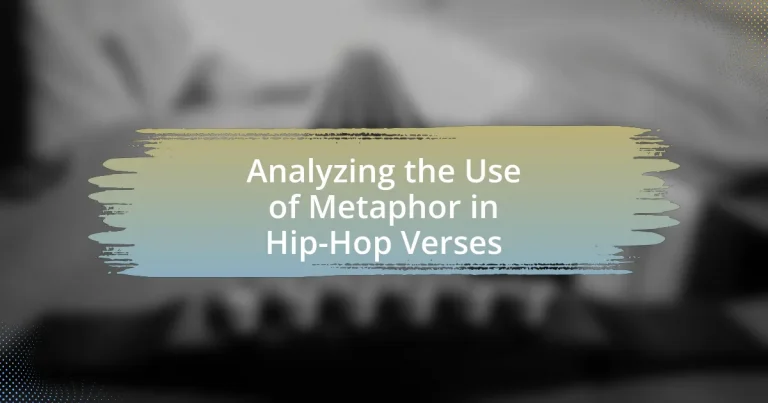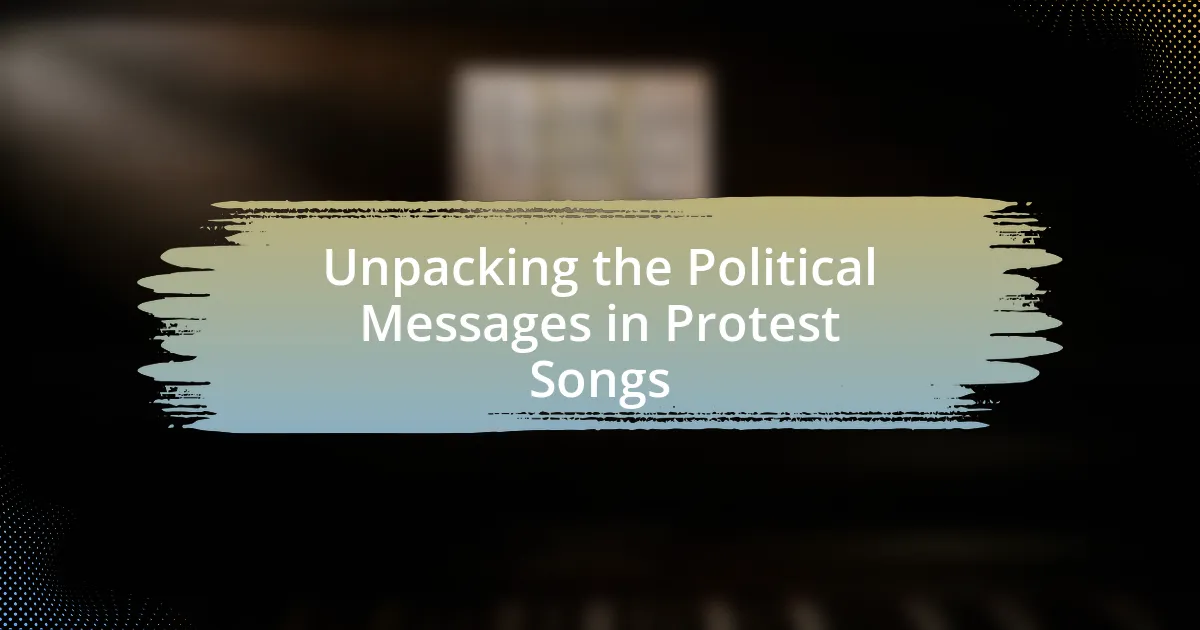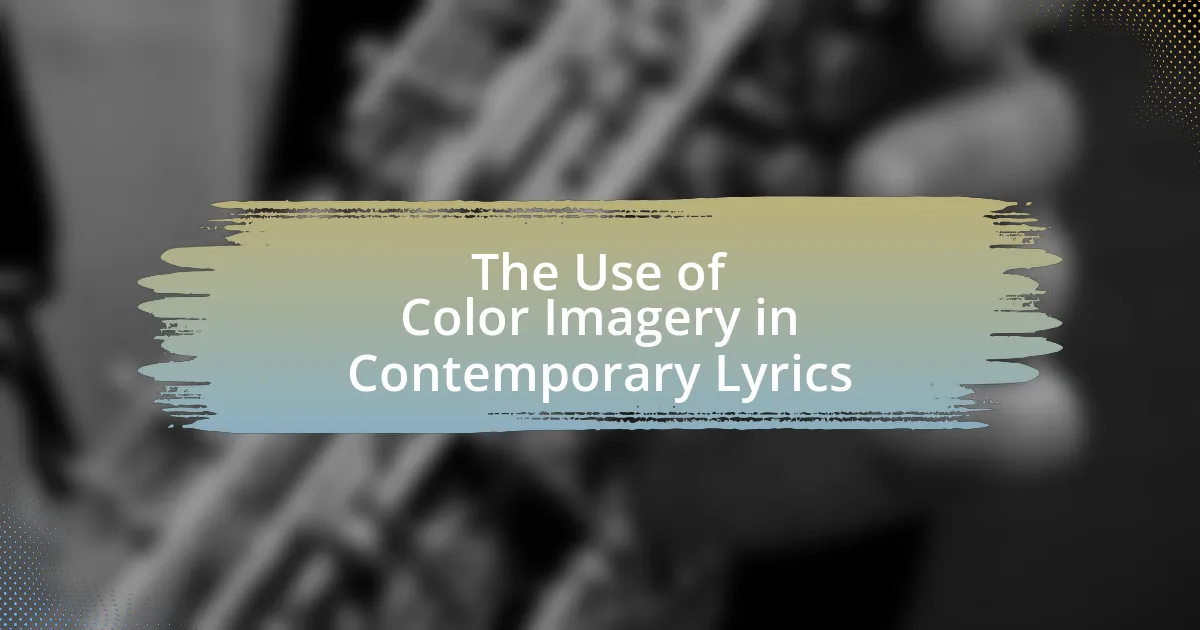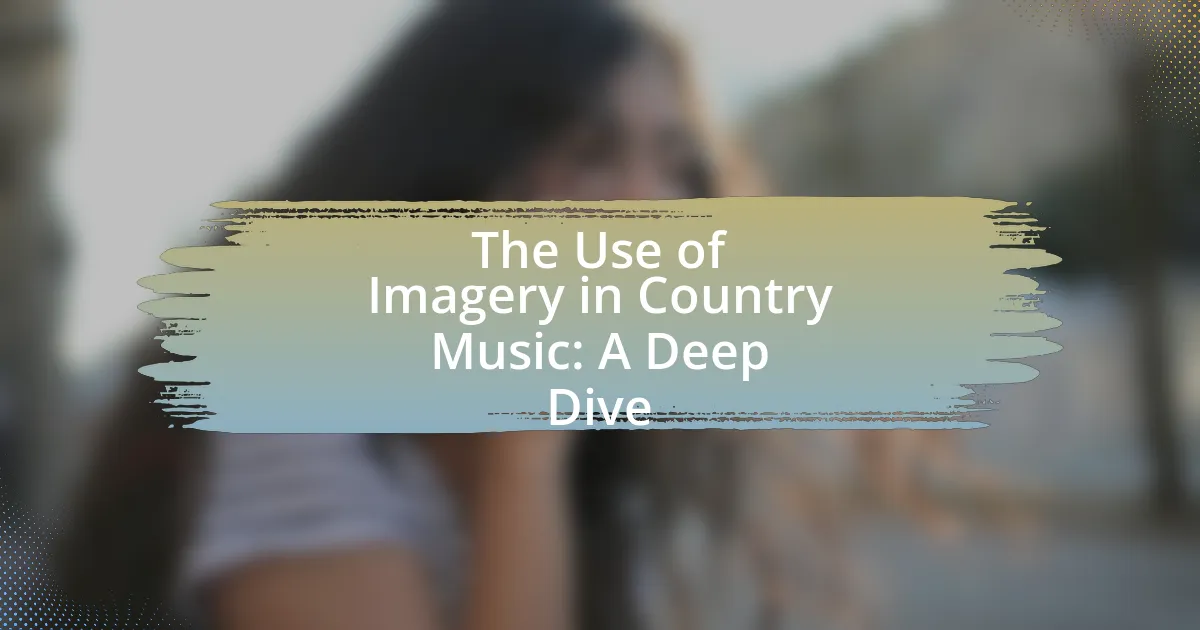The article focuses on the role of metaphor in hip-hop verses, highlighting its significance in enhancing lyrical depth and conveying complex emotions and ideas. It explores how metaphors enrich storytelling, engage listeners, and reflect the experiences of hip-hop artists, particularly in addressing social issues and personal struggles. The article also examines common types of metaphors used in hip-hop, the cultural contexts influencing their use, and the techniques for analyzing them. Additionally, it discusses the challenges artists face in using metaphors effectively and offers best practices for ensuring clarity and creativity in their lyrical expressions.
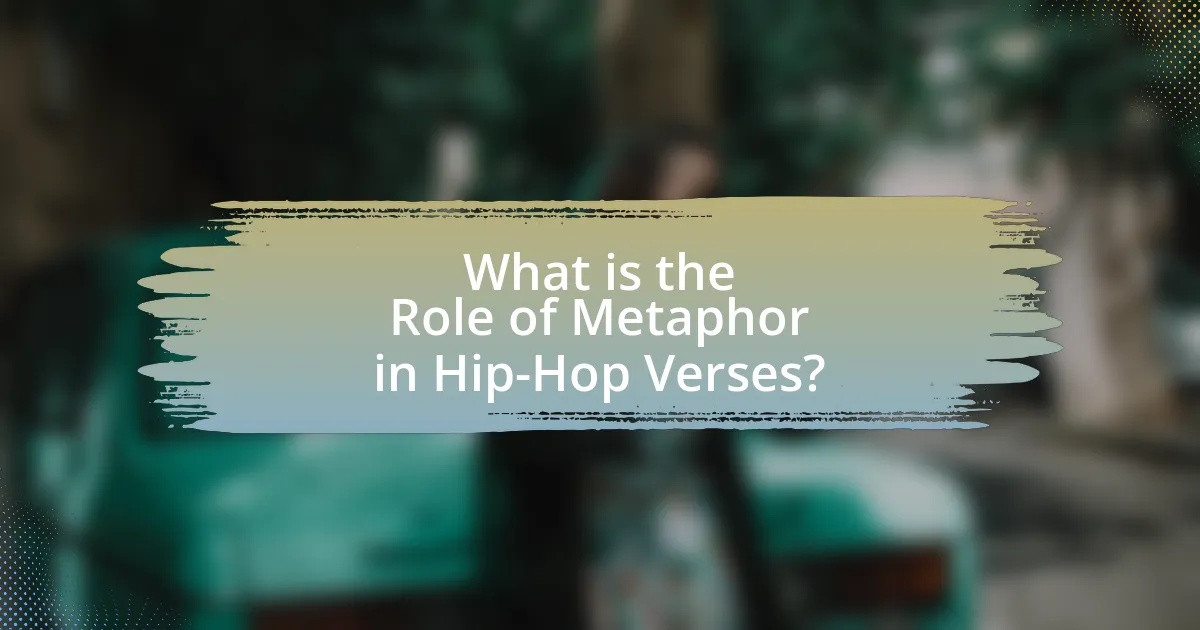
What is the Role of Metaphor in Hip-Hop Verses?
The role of metaphor in hip-hop verses is to enhance lyrical depth and convey complex emotions and ideas. Metaphors allow artists to express personal experiences and societal issues in a relatable manner, often using vivid imagery to create a stronger emotional impact. For instance, when Kendrick Lamar uses metaphors related to violence and survival, he not only illustrates his own struggles but also reflects broader themes of systemic oppression and resilience within the African American community. This technique enriches the narrative and engages listeners, making the verses more memorable and thought-provoking.
How do metaphors enhance the lyrical quality of hip-hop?
Metaphors enhance the lyrical quality of hip-hop by adding depth and complexity to the lyrics, allowing artists to convey emotions and ideas in a more vivid and relatable manner. This figurative language enables rappers to create imagery that resonates with listeners, making their messages more impactful. For instance, artists like Nas and Kendrick Lamar frequently employ metaphors to illustrate social issues, personal struggles, and cultural narratives, which enriches the storytelling aspect of their music. The use of metaphors also contributes to the rhythmic and phonetic qualities of the verses, as they often require creative wordplay and clever associations, thereby elevating the overall artistry of hip-hop.
What types of metaphors are commonly used in hip-hop lyrics?
Common types of metaphors used in hip-hop lyrics include similes, personification, and extended metaphors. Similes often compare two different things using “like” or “as,” enhancing imagery and emotional impact; for example, comparing life struggles to a race. Personification attributes human qualities to non-human elements, allowing artists to convey complex emotions, such as describing time as a thief. Extended metaphors develop a comparison throughout a verse or song, creating deeper meaning and connection, such as using a journey to symbolize personal growth. These metaphorical devices enrich the lyrical content and resonate with listeners, making hip-hop a powerful medium for storytelling and expression.
How do metaphors contribute to storytelling in hip-hop?
Metaphors significantly enhance storytelling in hip-hop by allowing artists to convey complex emotions and experiences in a relatable manner. Through the use of vivid imagery and symbolic language, metaphors enable rappers to express personal narratives, social issues, and cultural commentary, making their messages more impactful. For instance, in Kendrick Lamar’s “The Art of Peer Pressure,” he uses metaphors to illustrate the pressures of street life, effectively painting a picture of his experiences that resonates with listeners. This technique not only enriches the lyrical content but also fosters a deeper emotional connection between the artist and the audience, demonstrating the power of metaphor in hip-hop storytelling.
Why are metaphors significant in hip-hop culture?
Metaphors are significant in hip-hop culture because they enhance lyrical creativity and convey complex emotions and social commentary. In hip-hop, artists often use metaphors to create vivid imagery and connect with listeners on deeper levels, allowing them to express personal experiences and societal issues in a relatable manner. For instance, Nas’s use of metaphors in “The Message” illustrates the struggles of urban life, making abstract concepts tangible. This technique not only enriches the storytelling aspect of hip-hop but also engages audiences, fostering a shared understanding of cultural narratives.
What cultural contexts influence the use of metaphors in hip-hop?
Cultural contexts that influence the use of metaphors in hip-hop include socio-economic conditions, racial identity, and urban experiences. Socio-economic conditions shape the themes of struggle and resilience, often reflected in metaphors that convey hardship and aspiration. Racial identity plays a crucial role, as artists use metaphors to express cultural pride and critique systemic oppression, drawing from historical contexts such as the Civil Rights Movement. Urban experiences provide a backdrop for metaphors that depict life in marginalized communities, using vivid imagery to communicate the realities of street life, violence, and survival. These contexts collectively inform the rich metaphorical language found in hip-hop, making it a powerful medium for social commentary and personal expression.
How do metaphors reflect the experiences of hip-hop artists?
Metaphors reflect the experiences of hip-hop artists by encapsulating complex emotions and social realities in a relatable manner. Hip-hop artists often use metaphors to convey struggles with poverty, violence, and systemic oppression, allowing listeners to connect with their narratives on a deeper level. For instance, in Kendrick Lamar’s “The Art of Peer Pressure,” he employs metaphors to illustrate the pressures of street life and the impact of peer influence, effectively portraying the duality of his experiences. This use of metaphor not only enhances lyrical depth but also serves as a vehicle for social commentary, making the artists’ lived experiences accessible and impactful to a broader audience.
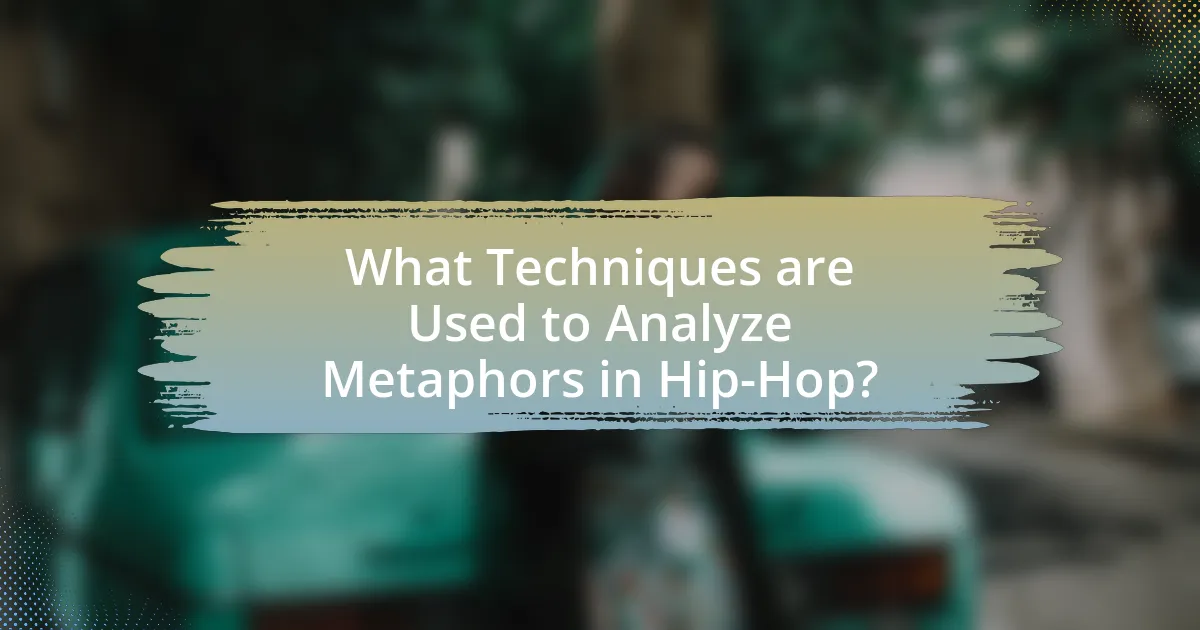
What Techniques are Used to Analyze Metaphors in Hip-Hop?
Techniques used to analyze metaphors in hip-hop include qualitative content analysis, metaphor identification procedures, and thematic analysis. Qualitative content analysis allows researchers to systematically categorize and interpret metaphorical language within lyrics, revealing underlying themes and cultural contexts. Metaphor identification procedures, such as the one developed by the Pragglejaz Group, provide a structured approach to pinpointing metaphors by focusing on linguistic cues and contextual meanings. Thematic analysis further enhances understanding by identifying recurring motifs and their implications in the socio-political landscape of hip-hop. These methods collectively enable a comprehensive examination of how metaphors function within the genre, reflecting artists’ experiences and societal commentary.
How can literary analysis be applied to hip-hop verses?
Literary analysis can be applied to hip-hop verses by examining the use of metaphor, imagery, and narrative techniques that convey deeper meanings and cultural contexts. Hip-hop artists often employ metaphors to articulate complex emotions and social issues, allowing listeners to engage with the text on multiple levels. For instance, in Kendrick Lamar’s “The Art of Peer Pressure,” the metaphor of peer influence serves to explore themes of identity and societal expectations. This analytical approach reveals how language shapes the listener’s understanding of personal and collective experiences, demonstrating the artistic depth of hip-hop as a literary form.
What specific methods are effective for dissecting metaphors in lyrics?
Effective methods for dissecting metaphors in lyrics include thematic analysis, contextual interpretation, and linguistic analysis. Thematic analysis involves identifying recurring themes and concepts within the lyrics, which helps to understand the underlying messages conveyed through metaphors. Contextual interpretation examines the cultural, social, and historical background of the lyrics, providing insight into the metaphor’s significance within its specific environment. Linguistic analysis focuses on the language structure, including word choice and syntax, to reveal how metaphors function within the lyrical framework. These methods are supported by research in literary analysis, which emphasizes the importance of context and language in understanding metaphorical meaning.
How does context affect the interpretation of metaphors in hip-hop?
Context significantly influences the interpretation of metaphors in hip-hop by shaping the listener’s understanding based on cultural, social, and historical backgrounds. For instance, metaphors referencing systemic oppression resonate differently with audiences familiar with racial injustices compared to those who are not. The use of specific slang, regional dialects, and personal experiences further contextualizes these metaphors, allowing for layered meanings that reflect the artist’s intent and the audience’s perception. Research indicates that metaphors in hip-hop often draw from shared cultural narratives, making context essential for accurate interpretation.
What role does audience perception play in metaphor analysis?
Audience perception is crucial in metaphor analysis as it determines how effectively metaphors resonate and convey meaning within hip-hop verses. The interpretation of metaphors relies heavily on the audience’s cultural background, personal experiences, and familiarity with the context, which influences their understanding and emotional response. For instance, a metaphor that references a specific cultural element may be interpreted differently by audiences from varying backgrounds, affecting the overall impact of the lyrics. Research indicates that audience engagement with metaphors can enhance their appreciation of the artistry and depth in hip-hop, as seen in studies like “Metaphor in Discourse” by Gerard Steen, which highlights the significance of audience context in metaphor comprehension.
How do listeners’ backgrounds influence their understanding of metaphors?
Listeners’ backgrounds significantly influence their understanding of metaphors by shaping their cultural, social, and linguistic contexts. For instance, individuals from different cultural backgrounds may interpret metaphors based on their unique experiences and societal norms, leading to varied meanings. Research indicates that familiarity with specific cultural references enhances metaphor comprehension; for example, a metaphor rooted in hip-hop culture may resonate more with listeners who are immersed in that environment, while others may struggle to grasp its significance. This phenomenon is supported by studies such as “Cultural Influences on Metaphor Comprehension” by Johnson and Lakoff, which demonstrate that background knowledge directly impacts metaphor interpretation.
What are common misconceptions about metaphors in hip-hop?
Common misconceptions about metaphors in hip-hop include the belief that they are solely for artistic flair or that they lack depth. In reality, metaphors in hip-hop serve as powerful tools for conveying complex emotions, social commentary, and personal narratives. For instance, artists like Nas and Kendrick Lamar use metaphors to address systemic issues and personal struggles, demonstrating that these figures of speech can encapsulate profound meanings and provoke thought. This depth is often overlooked, leading to an underestimation of the intellectual engagement required to fully appreciate hip-hop lyrics.
What Are the Impacts of Metaphor on Hip-Hop’s Message?
Metaphors significantly enhance hip-hop’s message by providing depth and emotional resonance. They allow artists to convey complex ideas and experiences in a relatable manner, often transforming personal narratives into universal themes. For instance, metaphors like “life is a game” or “the streets are a jungle” encapsulate struggles and triumphs, making the message more impactful. Research indicates that metaphorical language in hip-hop can increase listener engagement and comprehension, as it encourages audiences to interpret and connect with the lyrics on multiple levels. This use of metaphor not only enriches the storytelling aspect of hip-hop but also fosters a deeper cultural dialogue, reflecting societal issues and personal experiences.
How do metaphors shape the themes of hip-hop songs?
Metaphors shape the themes of hip-hop songs by providing deeper meanings and emotional resonance that enhance the listener’s understanding of complex social issues. For instance, artists often use metaphors to convey struggles with identity, systemic oppression, and personal experiences, allowing them to articulate nuanced perspectives on these topics. A notable example is Kendrick Lamar’s use of the metaphor of “the butterfly” in “The Blacker the Berry,” which symbolizes transformation and the duality of identity in the context of race. This metaphor not only enriches the song’s theme of racial identity but also invites listeners to reflect on broader societal implications. Thus, metaphors serve as a powerful tool in hip-hop, enabling artists to communicate intricate themes effectively.
What are some examples of powerful metaphors that convey social issues?
Powerful metaphors that convey social issues include “the system is rigged,” which illustrates systemic inequality, and “the streets are a jungle,” representing the dangers of urban life. These metaphors effectively encapsulate complex social realities, making them relatable and impactful. For instance, the phrase “the system is rigged” highlights the perceived unfairness in economic and political structures, often supported by statistics showing wealth disparity, such as the top 1% owning more than 40% of the nation’s wealth. Similarly, “the streets are a jungle” evokes imagery of survival and violence, reflecting the harsh conditions faced by marginalized communities, as evidenced by crime rates in urban areas. These metaphors serve as powerful tools in hip-hop to address and critique social issues.
How do metaphors create emotional connections with the audience?
Metaphors create emotional connections with the audience by allowing listeners to relate complex ideas and feelings to familiar experiences. This cognitive process engages the audience’s imagination, making abstract concepts more tangible and relatable. For instance, in hip-hop verses, artists often use metaphors to express struggles or triumphs, which resonate with listeners’ personal experiences, fostering empathy and understanding. Research by Lakoff and Johnson in “Metaphors We Live By” illustrates that metaphors shape our perceptions and emotions, reinforcing the idea that they are powerful tools for emotional engagement in communication.
What challenges do artists face when using metaphors?
Artists face several challenges when using metaphors, primarily related to clarity, audience interpretation, and cultural context. Clarity is crucial, as metaphors can obscure meaning if not crafted carefully, leading to confusion among listeners. Additionally, audience interpretation varies widely; what resonates with one demographic may alienate another, complicating the artist’s intent. Cultural context also plays a significant role; metaphors rooted in specific cultural references may not translate well across different audiences, risking misinterpretation. These challenges highlight the delicate balance artists must maintain to effectively communicate their messages through metaphor in hip-hop verses.
How can overuse of metaphors dilute their impact in hip-hop?
Overuse of metaphors in hip-hop can dilute their impact by making lyrics feel clichéd and less relatable. When artists excessively rely on metaphors, the originality and emotional resonance of their messages can diminish, leading listeners to disengage. For instance, frequent use of common metaphors, such as comparing life to a game or struggle to a battle, can render the lyrics predictable and less striking. This phenomenon is supported by linguistic studies indicating that novelty in language enhances listener engagement, while repetitive imagery can lead to desensitization. Therefore, maintaining a balanced use of metaphors is crucial for preserving their effectiveness in conveying deeper meanings in hip-hop.
What are the risks of misinterpretation of metaphors in lyrics?
The risks of misinterpretation of metaphors in lyrics include misunderstanding the intended message, which can lead to distorted perceptions of the artist’s views or experiences. Misinterpretation may result in listeners drawing incorrect conclusions about themes such as identity, social issues, or personal struggles, which are often central to hip-hop verses. For instance, a metaphor about violence might be interpreted literally, obscuring the artist’s commentary on systemic issues rather than glorifying aggression. This misreading can perpetuate stereotypes and hinder meaningful discourse around the topics addressed in the lyrics.
What Best Practices Can Artists Follow When Using Metaphors?
Artists can enhance their use of metaphors by ensuring clarity, relevance, and originality in their expressions. Clarity allows the audience to easily grasp the intended meaning, while relevance ensures that the metaphor aligns with the overall theme of the work. Originality prevents clichés and engages listeners by presenting fresh perspectives. For instance, in hip-hop, artists like Kendrick Lamar often employ unique metaphors that resonate with personal experiences, making their messages impactful and relatable. This approach not only captivates the audience but also deepens the emotional connection to the lyrics.
How can artists ensure clarity while maintaining creativity in their metaphors?
Artists can ensure clarity while maintaining creativity in their metaphors by using relatable imagery and precise language. By grounding their metaphors in familiar experiences or emotions, artists can create vivid connections that resonate with their audience. For instance, a hip-hop artist might compare struggles to climbing a mountain, which conveys both the challenge and the journey in a way that listeners can easily visualize and understand. This approach not only enhances the metaphor’s impact but also ensures that the underlying message remains clear, allowing for both artistic expression and effective communication.
What strategies can be employed to effectively convey complex ideas through metaphor?
To effectively convey complex ideas through metaphor, one strategy is to use relatable imagery that resonates with the audience’s experiences. This approach allows listeners to connect abstract concepts to familiar situations, enhancing understanding. For instance, in hip-hop, artists often draw on everyday life scenarios, such as struggles or triumphs, to illustrate deeper themes like resilience or social injustice. This technique is supported by research indicating that metaphors grounded in common experiences facilitate cognitive processing and retention of complex information, as shown in studies by Lakoff and Johnson in “Metaphors We Live By.” By employing vivid and accessible metaphors, artists can bridge the gap between intricate ideas and audience comprehension.
